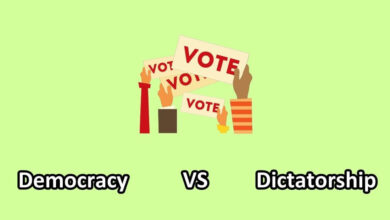Society and community are two terms that are often used interchangeably, but they are not the same. Although both involve groups of people living together, they have distinct differences in terms of their characteristics and functions. In this article, we will explore the differences between society and community, including their definitions, characteristics, and examples. So let’s first have a look at a table that describes society and community difference in a brief manner.
Society and Community Difference (Chart)
| Society | Community |
|---|---|
| A society is a large group of individuals who share common characteristics such as culture, political system, interests, opinions, etc in a specific geographical area. | A community is a smaller group of individuals who share common characteristics such as religion, morals, customs, values, etc living in the same area or having a sense of belonging to each other. |
| It is typically a larger unit and is made of multiple communities. | It is typically smaller, as compared to society. |
| Society is often characterized by a high level of diversity in the terms of culture, language, and socioeconomic status. | A community is often characterized by homogeneity in the terms of shared values, norms, and traditions. |
| It is abstract in nature | It is concrete in nature |
| It is not essential for members of a society to share common interests, objectives, opinions, or perceptions. | It is essential for residents of a community to share similar hobbies, objectives, perspectives, and opinions. |
| Society is heterogeneous i.e, there is diversity among the members. | A community is homogeneous i.e, there is less or no diversity among the members. |
| It is not confined to any specific territory or geographical area. | It is confined to a particular territory and geographical area. |
| Communication and interaction are important in society. | People in the community may communicate unintentionally. Therefore it is not necessary to interact. |
You Can Also Read:
- Difference Between Race and Ethnicity
- Difference Between Absolute and Relative Poverty
- Difference Between Sociology and Anthropology
What is Society?
A society is a group of individuals who share a common culture, norms, and values. It is a complex network of social relationships that connect people in a specific geographical area. In other words, society is a group of individuals who share a common culture, territory, and institutions. It is a broader term that refers to the entire network of relationships and interactions among individuals, groups, and institutions within a given geographical area.
Society includes people from different backgrounds, with varying beliefs, values, and lifestyles. These individuals interact with one another through a range of social institutions, such as family, religion, education, government, and the economy. For example, the United States is a society that consists of different ethnic groups, religions, and social classes. Despite their differences, they share common values such as democracy, freedom, and equality.
5 Characteristics of Society
- Social Structure: Society has a social structure that defines the relationships between individuals and groups. It includes institutions such as family, education, government, and religion.
- Culture: Society has a shared culture that consists of language, beliefs, customs, and traditions. It provides a sense of identity and belonging to its members.
- Norms and Values: Society has norms and values that guide the behavior of its members. They are the rules and standards of conduct that are enforced through social sanctions such as praise or punishment.
- Socialization: Society socializes its members through the process of education, which teaches them the norms, values, and beliefs of the culture.
- Change: Society is dynamic and constantly changing. It adapts to new challenges and experiences, which can lead to cultural evolution.
What is Community?
A community is a group of people who share a common interest, goal, or location. It is a more specific and localized form of society. It is a group of people who are connected by their social relationships, shared values, and sense of belonging. A community can be defined by a physical location, such as a neighborhood, or by a shared characteristic, such as a cultural or religious identity.
Community members often work together to achieve common goals and support one another in times of need. In many cases, communities are subgroups within larger societies. For example, a neighborhood community consists of individuals who live in the same area and share common facilities such as parks, schools, and shops.
5 Characteristics of Community
- Membership: A community has a defined membership that shares a common identity or interest. It can be based on geographical location, ethnicity, religion, or profession.
- Interaction: Community members interact with each other regularly and share a sense of belonging. They may have social events, meetings, or gatherings that strengthen their relationships.
- Shared Values: The community has shared values that guide the behavior of its members. They may have a common goal, mission, or vision that they work towards.
- Support: The community provides support to its members during times of need. They may offer emotional, financial, or practical help.
- Involvement: Community members are involved in decision-making and problem-solving. They have a sense of ownership and responsibility for the well-being of their community.
Society Vs Community (Comparison Table)

Key Differences between Society and Community
While comparing society vs community, here we have included some of the 6 key differences between them. They are as follows.
- Scope: Society is a broader concept that encompasses multiple communities. It refers to the collective of individuals living in a specific geographical area. In contrast, a community is a smaller and more specific group of individuals who share a common interest, goal, or location.
- Culture: Society has a shared culture that includes language, beliefs, customs, and traditions. The community may have a subculture that is unique to its members but is influenced by the larger society.
- Membership: The society has an open membership that is not defined by specific criteria. Anyone who resides in the geographical area can be considered a member. On the other hand, a community has a defined membership that shares a common identity or interest.
- Interaction: Society members may not interact with each other regularly. In contrast, community members interact with each other regularly and share a sense of belonging.
- Size: Society can be large and impersonal, consisting of millions of individuals. On the other hand, a community is smaller and more personal, consisting of hundreds or thousands of individuals.
- Purpose: Society has multiple functions, including providing social order, security, and economic stability.
You Can Also Read:
Conclusion
In conclusion, while society and community are often used interchangeably, they are two distinct concepts with their own characteristics and nuances. Society refers to the broader social structures and institutions that regulate social behavior and maintain order, while community refers to smaller, more localized groups of individuals who share a common interest, location, or goal.
Understanding the society and community difference is important because it helps us to better understand the world around us and how it can inform our interactions with others and help us to appreciate the importance of both societal structures and community connections in shaping our experiences and shaping our societies as a whole. Ultimately, recognizing and valuing both society and community is essential to building a more just, equitable, and inclusive world.
Reference Blog:



